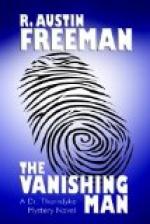I was in good time at my tryst, despite the hindrances of fried plaice and invalid guillotinists; but, early as I was, Miss Bellingham was already waiting in the garden—she had been filling a bowl with flowers—ready to sally forth.
“It is quite like old times,” she said, as we turned into Fetter Lane, “to be going to the Museum together. It brings back the Tell el Amarna tablets and all your kindness and unselfish labour. I suppose we shall walk there to-day?”
“Certainly,” I replied; “I am not going to share your society with the common mortals who ride in omnibuses. That would be sheer, sinful waste. Besides, it is more companionable to walk.”
“Yes, it is; and the bustle of the streets makes one more appreciative of the quiet of the Museum. What are we going to look at when we get there?”
“You must decide that,” I replied. “You know the collection much better than I do.”
“Well, now,” she mused, “I wonder what you would like to see; or, in other words, what I should like you to see. The old English pottery is rather fascinating, especially the Fulham ware. I rather think I shall take you to see that.”
She reflected awhile, and then, just as we reached the gate of Staple Inn, she stopped and looked thoughtfully down the Gray’s Inn Road.
“You have taken a great interest in our ‘case,’ as Doctor Thorndyke calls it. Would you like to see the churchyard where Uncle John wished to be buried? It is a little out of our way, but we are not in a hurry, are we?”
I, certainly, was not. Any deviation that might prolong our walk was welcome, and, as to the place—why, all places were alike to me if only she were by my side. Besides, the churchyard was really of some interest, since it was undoubtedly the “exciting cause” of the obnoxious paragraph two of the disputed will. I accordingly expressed a desire to make its acquaintance, and we crossed to the entrance to Gray’s Inn Road.
“Do you ever try,” she asked, as we turned down the dingy thoroughfare, “to picture to yourself familiar places as they looked a couple of hundred years ago?”
“Yes,” I answered, “and very difficult I find it. One has to manufacture the materials for reconstruction, and then the present aspect of the place will keep obtruding itself. But some places are easier to reconstitute than others.”
“That is what I find,” said she. “Now Holborn, for example, is quite easy to reconstruct, though I daresay the imaginary form isn’t a bit like the original. But there are fragments left, like Staple Inn and the front of Gray’s Inn; and then one has seen prints of the old Middle Row and some of the taverns, so that one has some material with which to help out one’s imagination. But this road that we are walking in always baffles me. It looks so old and yet is, for the most part, so new that I find it impossible to make a satisfactory picture of its appearance, say, when Sir Roger de Coverley might have strolled in Gray’s Inn Walks, or farther back, when Francis Bacon had chambers in the Inn.”




